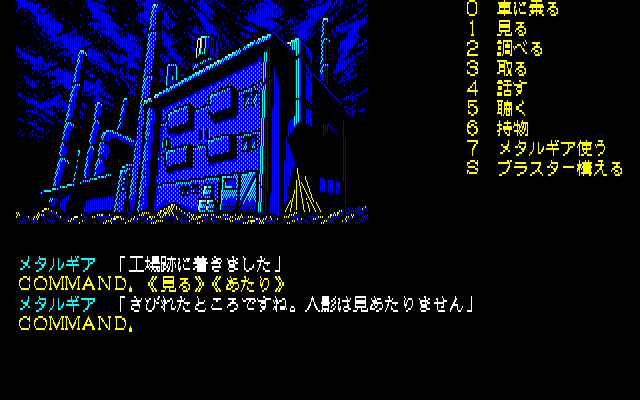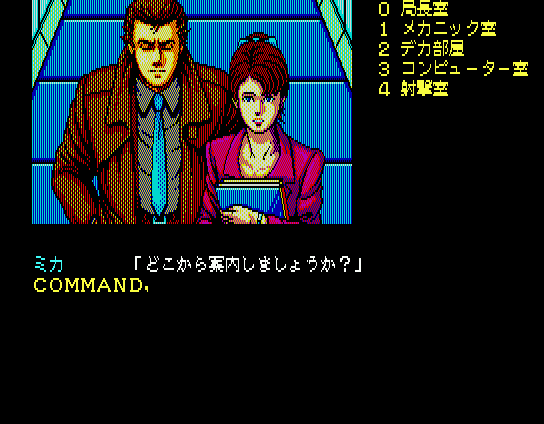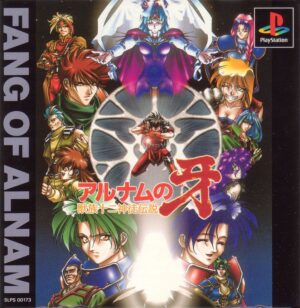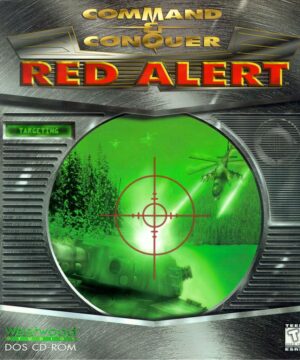Retro Replay Review
Gameplay
Snatcher unfolds as a classic Japanese-style graphic adventure, placing you in the shoes of JUNKER operative Gillian Seed as he hunts down the mysterious bio-roid killers known as Snatchers. The core gameplay loop revolves around exploring Neo Kobe City’s various locales, examining environments, and engaging in rich dialogue exchanges. You navigate through a menu-driven interface where commands like “Move,” “Examine,” and “Talk” guide your progress, and every item you inspect often yields a descriptive or humorous commentary that deepens the immersion.
(HEY YOU!! We hope you enjoy! We try not to run ads. So basically, this is a very expensive hobby running this site. Please consider joining us for updates, forums, and more. Network w/ us to make some cash or friends while retro gaming, and you can win some free retro games for posting. Okay, carry on 👍)
While most of the game is devoted to investigation and conversation, Snatcher peppers in moments of tension with its signature shooting gallery sequences. At key narrative junctures, Snatchers erupt from hiding, and you must react quickly—aiming and firing before the timer runs out or before Gillian falls. These reflex-based segments break up the pacing of slower detective work, offering a pulse-pounding contrast to the methodical clue-gathering.
Puzzle-solving, surprisingly, takes a back seat. True to Hideo Kojima’s vision, the emphasis is on narrative revelation rather than brain-teasers. Although you’ll occasionally combine items or use evidence against suspects, most challenges hinge on choosing the right conversation topics or timing your shots in combat. For players craving complex inventory puzzles, Snatcher may feel refreshingly straightforward or perhaps a little light—but it keeps the story flowing without tedious roadblocks.
Graphics
Originally showcased on the PC Engine and later on the Sega CD, Snatcher’s visuals marry gritty cyberpunk noir with late-’80s pixel art charm. Neo Kobe City’s rain-soaked streets flicker with neon signs, while interiors of bars and laboratories sport a moody palette that reinforces the sense of decay and high-tech paranoia. Character sprites, though modest in resolution, convey emotion through subtle posture shifts and expressive portraits during dialogue.
Cutscenes—especially in the CD-ROM version—feature animated sequences with a slightly higher frame rate, giving key moments of drama an added cinematic flair. These sequences, combined with portrait shots during exchanges, feel remarkably modern for a title of its era. Even today, the interplay of static backgrounds with animated character art creates a distinctive atmosphere that stands out among retro adventure games.
Environmental details further enhance immersion: dripping water stains on concrete walls, flickering overhead lights, and the occasional glimpse of Snatcher victims before they strike. While you won’t find high-resolution textures or 3D models, the game’s aesthetic consistency and clever use of color evoke a palpable sense of danger, perfectly complementing its thriller narrative.
Story
At its heart, Snatcher is a sci-fi detective thriller set in the unsettling year of 2047 (or 2042 in the Japanese original). Neo Kobe City stands on the brink of chaos, as Snatchers—bio-roid assassins—murder citizens and assume their identities. Is this the work of a rogue government program, or are these intruders from beyond our world? The game keeps you guessing, dripping out lore in bite-sized revelations.
You step into the boots of Gillian Seed, a JUNKER (Japanese Undercover Neuro-Kinetic Elimination Ranger), tasked with uncovering the Snatcher conspiracy. The narrative unfolds through a series of investigations, interrogations, and thrills, driven by Kojima’s knack for cinematic pacing and genre homage. You’ll question suspects, confront corrupt officials, and team up with memorable allies like the enigmatic Jamie and the stoic Brad, each with their own agendas and mysteries.
Snatcher isn’t just a murder mystery—it’s an exploration of identity, humanity, and trust in a world where a single misstep could mean facing a killer wearing your friend’s face. Through its twists and revelations, the game maintains a tension that not only fuels the plot but keeps you emotionally invested in Gillian’s quest for justice.
Overall Experience
Playing Snatcher today feels like discovering a lost cyberpunk gem. Its fusion of investigative gameplay, pulse-pounding shooting segments, and richly woven narrative remains engaging decades after its original release. While the adventure mechanics may seem dated compared to modern point-and-click titles, the evocative storytelling and authoritative direction hold up remarkably well.
Audio design plays a pivotal role in the experience: a brooding synth-heavy soundtrack underscores every rainy alleyway and shadowy lab, while voice samples in the CD-ROM version add grit and immediacy to dialogue exchanges. Occasional cheesy sound effects lend a retro flavor that fans of ’90s console gaming will either cherish or chuckle at, depending on taste.
For prospective buyers, Snatcher represents a unique blend of noir detective work and sci-fi suspense. If you appreciate story-driven adventures that favor atmosphere and characterization over convoluted puzzles, and if you’re drawn to the darker side of futuristic cityscapes, Snatcher promises an unforgettable journey. It stands as both a testament to Kojima’s early brilliance and a must-play for anyone curious about the roots of modern narrative gaming.
 Retro Replay Retro Replay gaming reviews, news, emulation, geek stuff and more!
Retro Replay Retro Replay gaming reviews, news, emulation, geek stuff and more!









Reviews
There are no reviews yet.